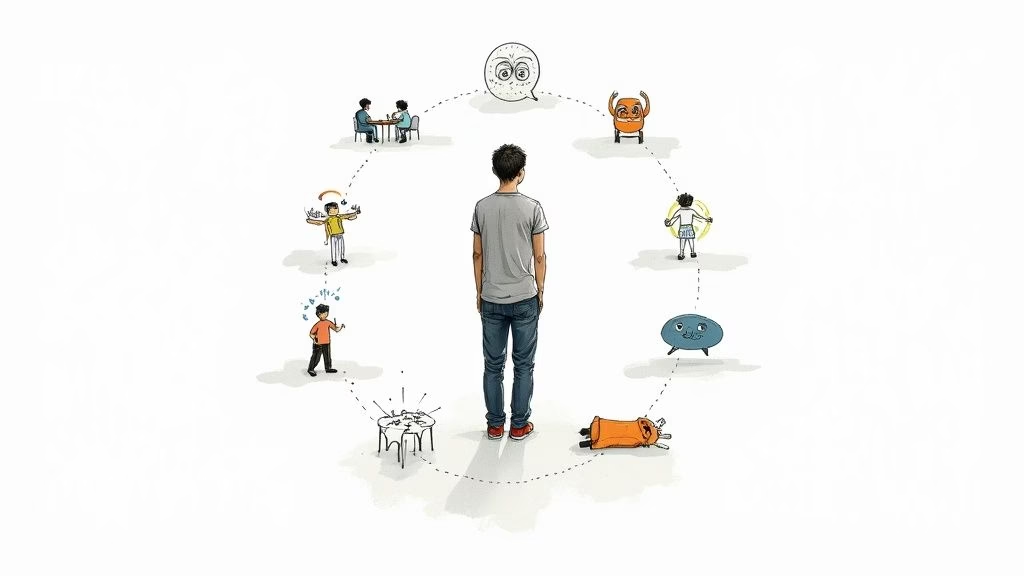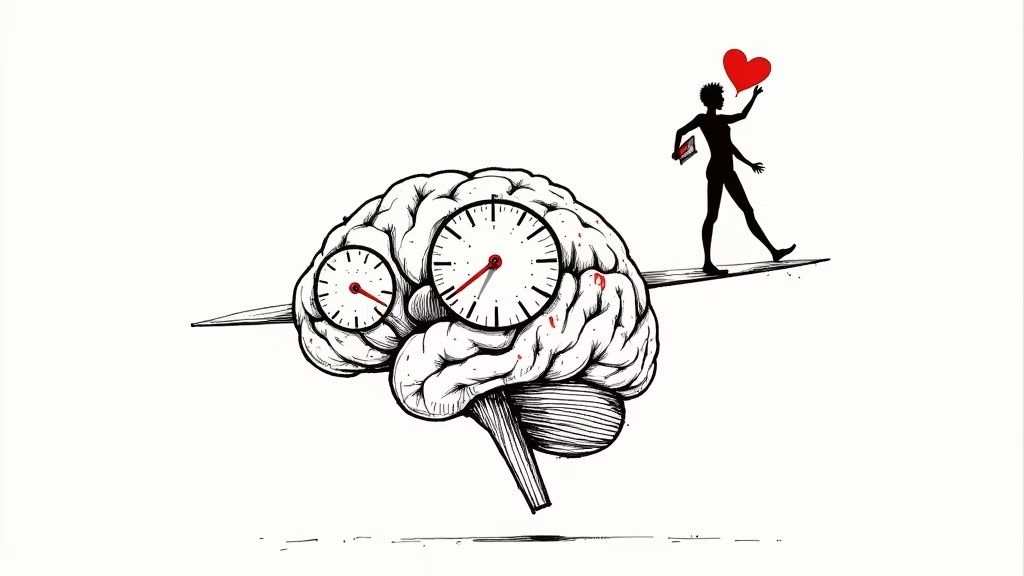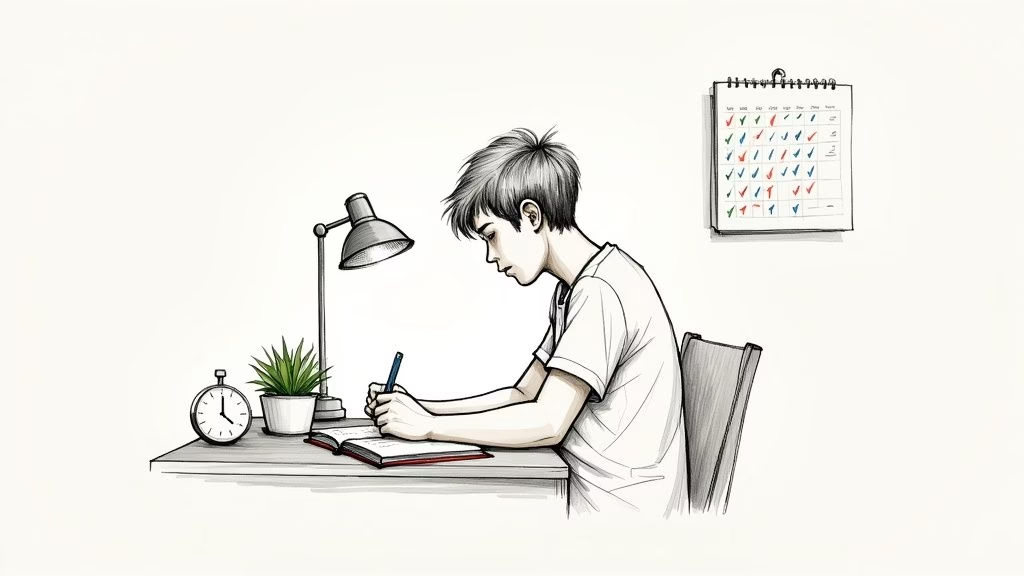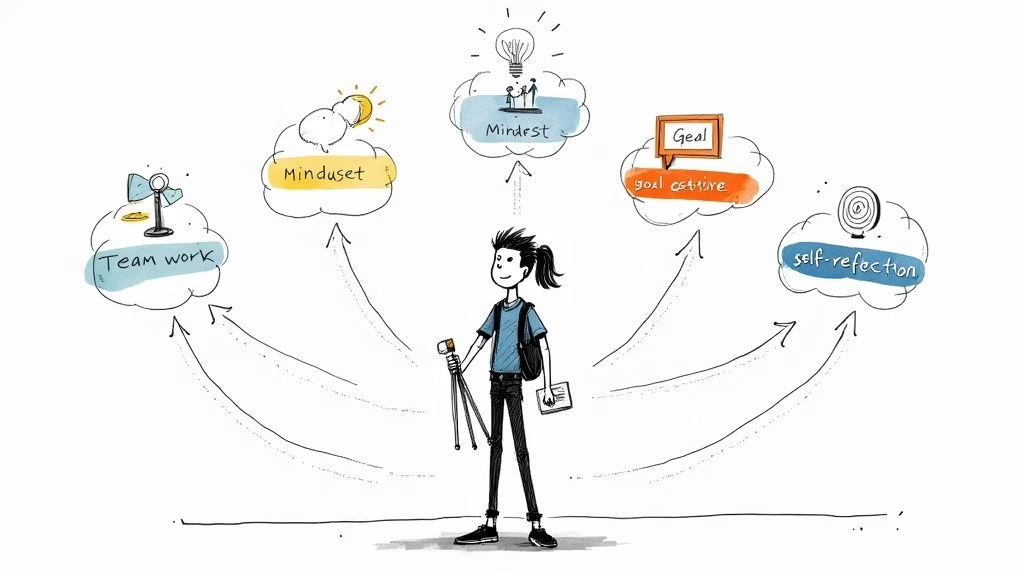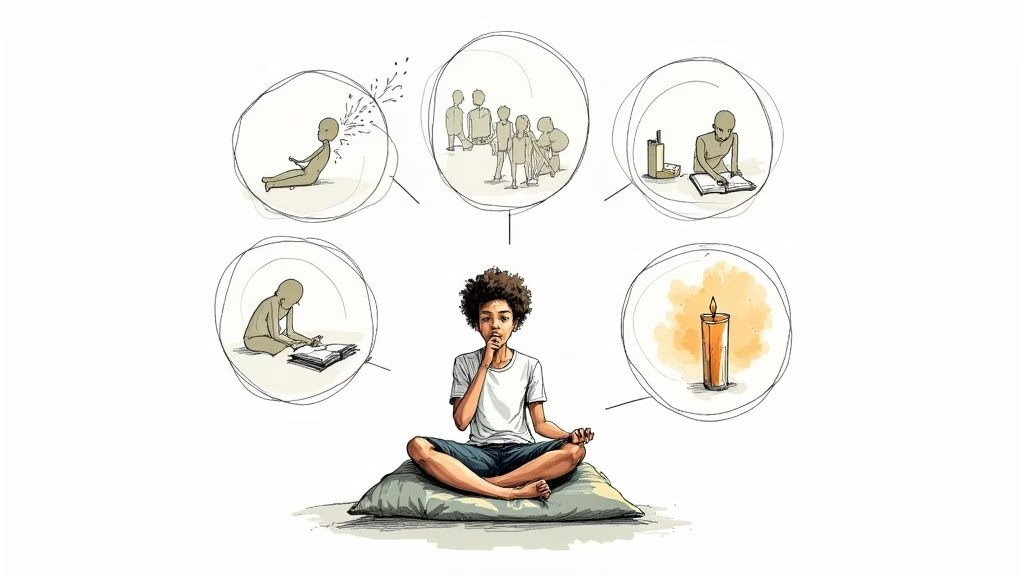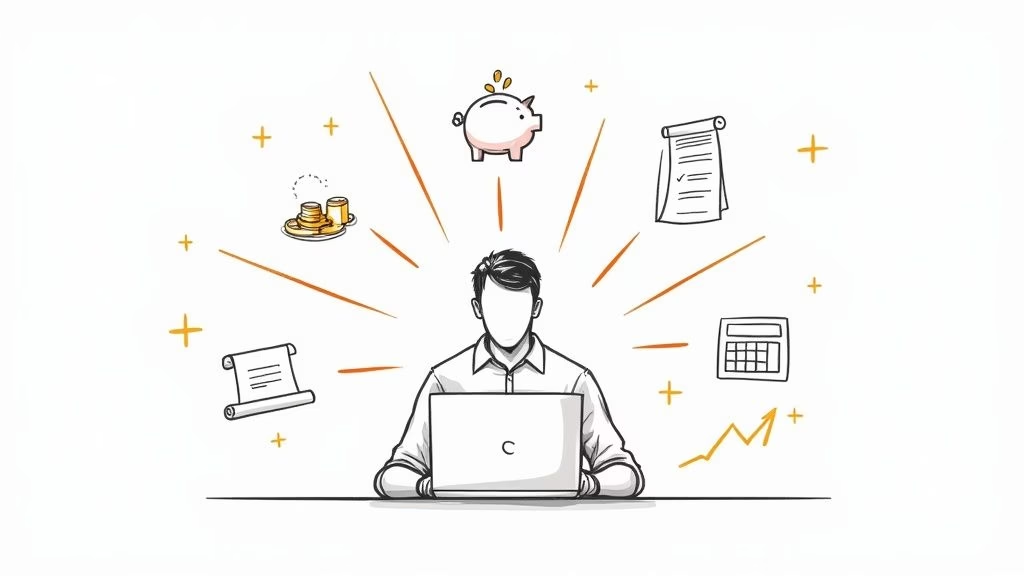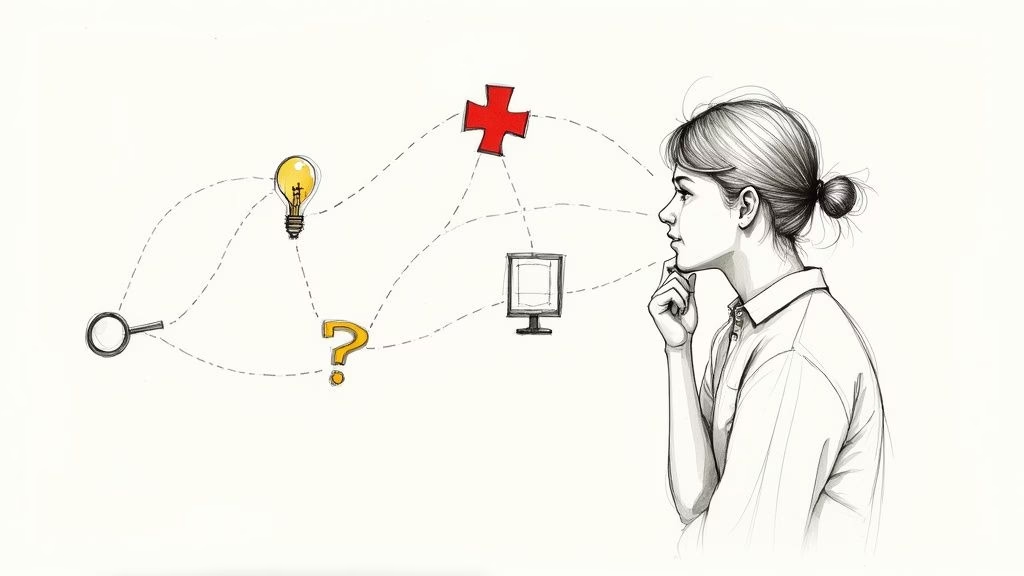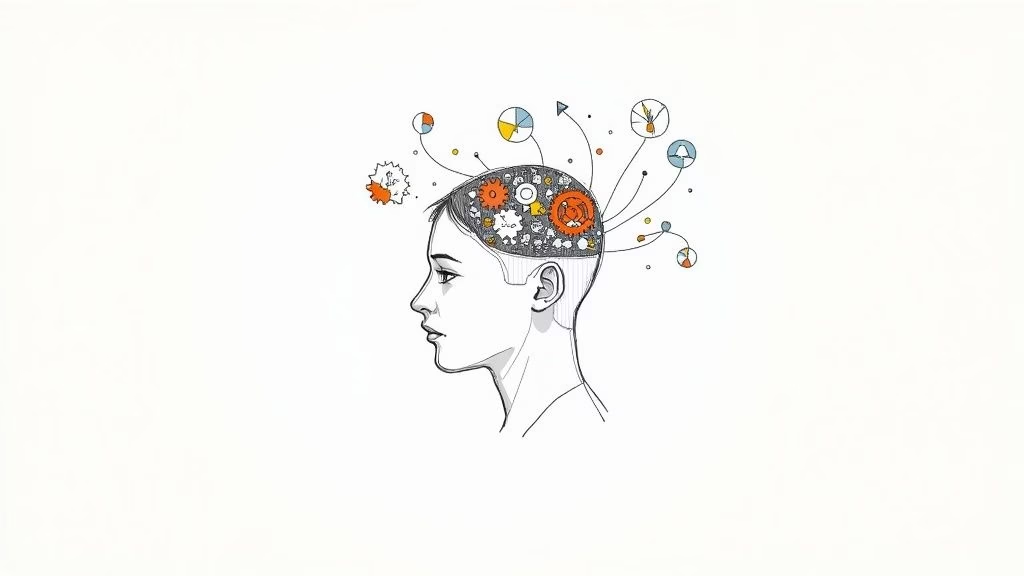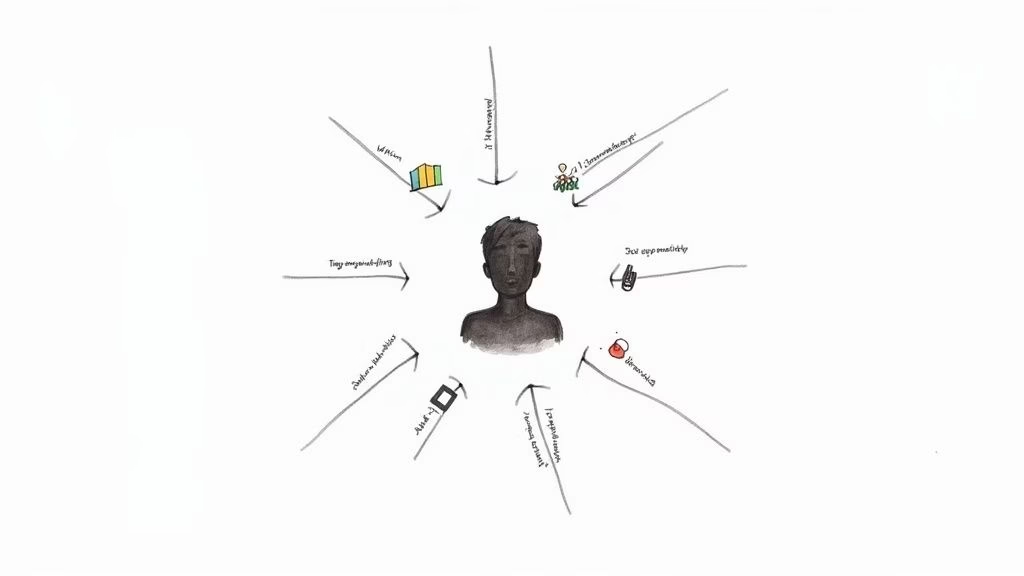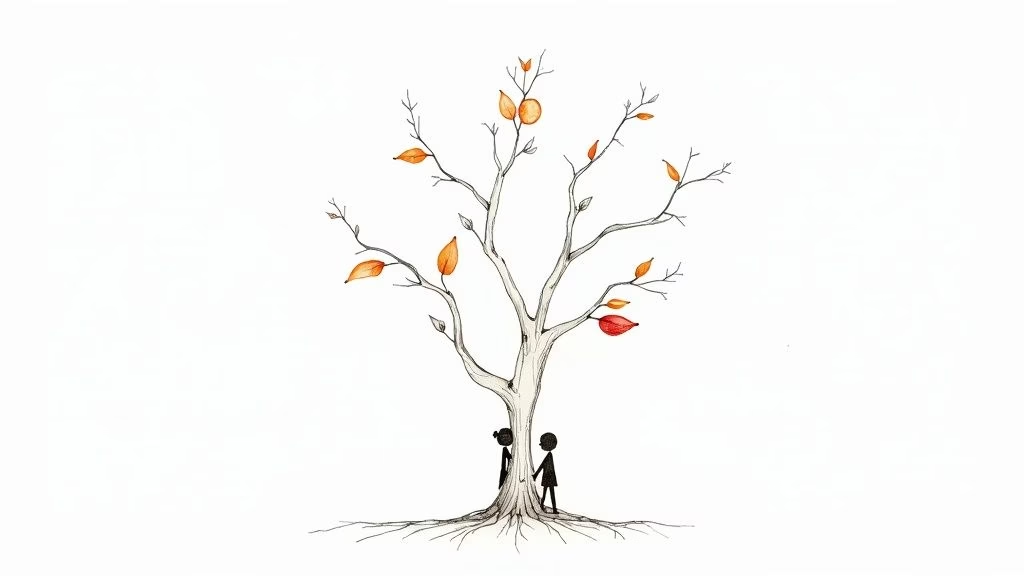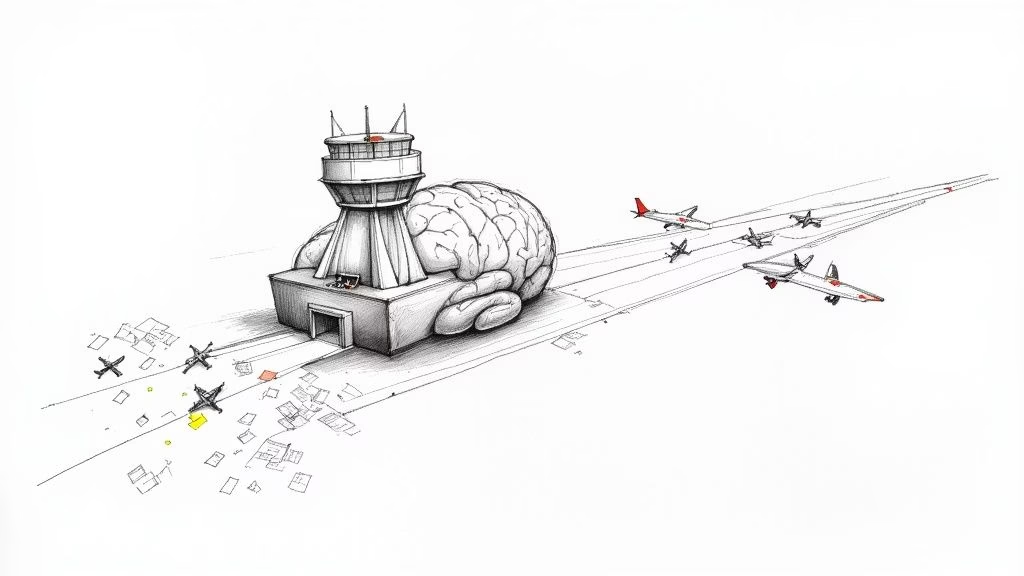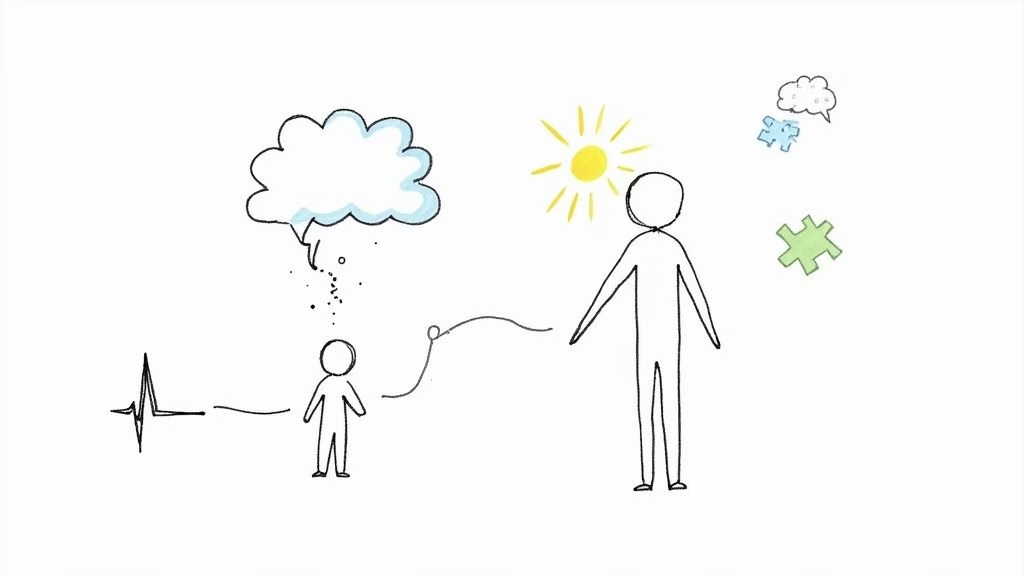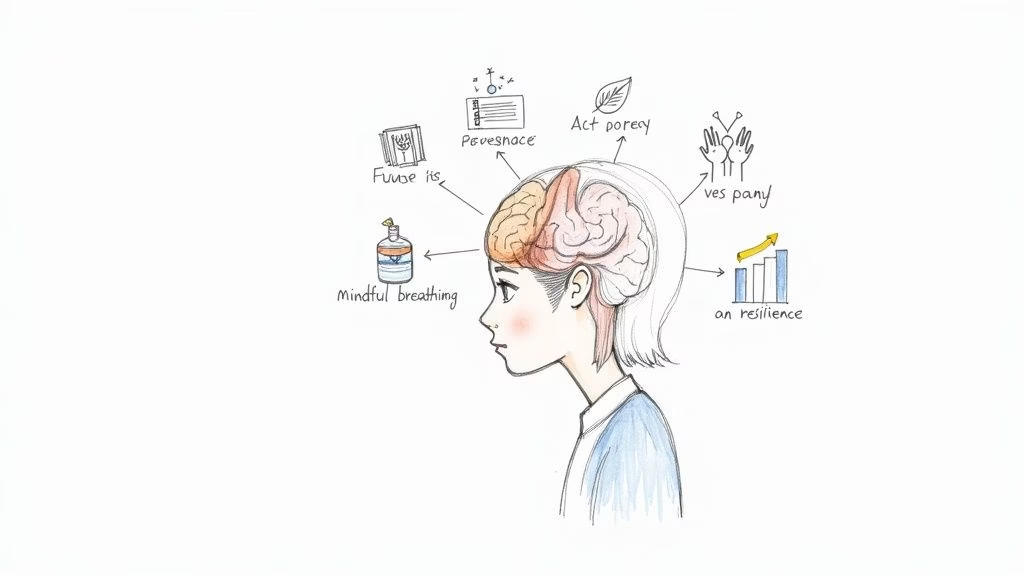Let's be real—feeling anxious is a normal part of life. Everyone feels it. Especially when you're juggling school, a social life that's always online, and just trying to figure out who you are. The first step in learning how to reduce anxiety isn't to fight it, but to understand it. Think of it less as a personal flaw and more as a signal from your body and mind that something needs your attention. Simply acknowledging what’s happening is a huge first step toward getting a handle on it.
Understanding Anxiety in a Teen's World
For teenagers, anxiety can feel like a constant, unwelcome guest. The pressure to get good grades, fit in with friends, and plan for the future can create a perfect storm of worry. It’s that knot in your stomach before a big test, or the racing thoughts that keep you awake long after a minor argument with a friend.
This feeling isn't just in your head. It’s a biological fight-or-flight response that's been wired into humans for ages. The problem is, modern life has added new layers of complexity. Social pressures don’t just stop when the school bell rings anymore. Thanks to social media, they follow you home, making anxiety feel totally inescapable.
The Link Between Anxiety, Motivation, and School
Ever notice how hard it is to focus when you're anxious? That's because your brain has switched into "threat" mode, making it nearly impossible to concentrate on homework or studying. This is where that frustrating cycle of procrastination kicks in. You feel overwhelmed by a big project, which triggers anxiety. To get away from that awful feeling, you put the task off. You get a little temporary relief, but the stress just comes back bigger and meaner later on.
This avoidance can look a lot like a lack of motivation, but more often than not, it’s just a coping mechanism for anxiety. It’s not that you don't want to do well; it's that the fear of not being good enough feels too heavy to deal with. Understanding this connection is a game-changer for both teens and their parents.
Recognizing that procrastination is often a symptom of anxiety, not laziness, is a breakthrough. It shifts your thinking from "I need to stop being so lazy" to "I need to figure out how to manage this overwhelming feeling."
A Parent's Role in Acknowledging Teen Anxiety
For parents, watching your teen struggle with anxiety is incredibly tough. Your first instinct might be to jump in and "fix" it, but the most powerful thing you can do is create a safe, no-judgment zone for them to talk. Acknowledging their feelings without rushing to offer solutions builds the trust they need to open up.
Sometimes, a simple phrase like, "It sounds like you're under a lot of pressure right now," can make all the difference.
It also helps to remember that the world teens are growing up in is fundamentally different. The constant stream of bad news and global uncertainty has created a baseline level of unease for everyone. For instance, the COVID-19 pandemic led to a staggering 25% increase in the global prevalence of anxiety in just its first year, fueled by social isolation and fear. You can read more about these mental health trends from the World Health Organization.
Building a Foundation for Support
Knowing where to find reliable information is empowering for everyone involved. Good resources can give both teens and parents proven strategies and a much deeper understanding of what's going on.
Here are a couple of great places to start:
- The National Institute of Mental Health (NIMH): They offer comprehensive, research-backed guides on anxiety disorders.
- The Anxiety & Depression Association of America (ADAA): This organization provides resources specifically created for teens and young adults.
Building this foundation of knowledge is the first real step in turning anxiety from an overwhelming force into something you can actually manage.
Immediate Ways to Calm an Anxious Mind
When anxiety spikes and your mind starts racing, you need tactics that work right now. These aren’t just flimsy distractions; they are science-backed strategies that send a direct message to your nervous system, telling it to stand down from high alert.
The best part? You can use them anywhere—before a big exam, after a tough conversation, or whenever that to-do list feels like it's crushing you.
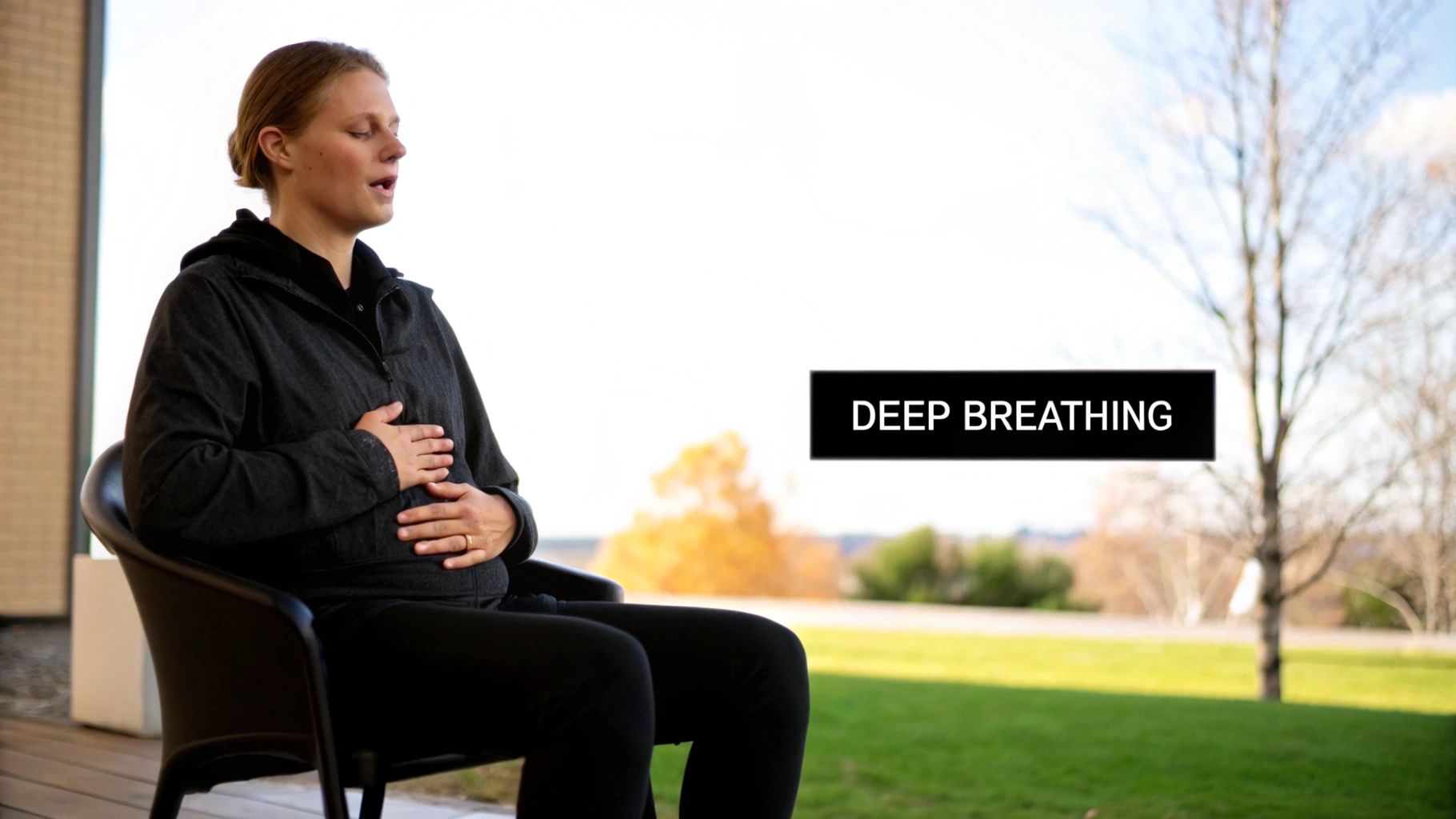
The key is to pull your attention away from the "what if" thoughts spinning in your head and ground yourself firmly in this very moment. This simple act interrupts the anxiety cycle and gives you a chance to feel in control again.
Master Your Breathing to Manage Stress
Your breath is one of the most powerful, and immediate, tools you have for dialing down anxiety. Think about it: when you get anxious, your breathing gets shallow and quick, which just keeps your body stuck in panic mode. By consciously slowing your breath down, you send a clear signal to your brain that the danger has passed.
A simple yet incredibly effective method is box breathing. It’s easy to remember, even when you feel like your brain is short-circuiting from stress.
- Inhale slowly for a count of four.
- Hold your breath at the top for another count of four.
- Exhale slowly through your mouth for a count of four.
- Hold the exhale for a final count of four.
Just a few cycles of this rhythmic pattern can help regulate your heart rate and give your mind something to focus on besides your worries.
Another great one is the 4-7-8 method. Find a comfortable spot, sitting or lying down. Inhale quietly through your nose for four seconds, hold that breath for seven seconds, and then exhale audibly through your mouth for eight full seconds. That long exhale is the real magic here—it’s especially good at activating your body's natural relaxation response.
Ground Yourself with the 5-4-3-2-1 Method
When your thoughts are spiraling out of control, grounding exercises are your ticket back to reality. The 5-4-3-2-1 method is a sensory-based trick that forces your brain to pay attention to your immediate surroundings instead of getting lost in internal worries.
It's super straightforward:
- Acknowledge 5 things you can see. Look around you. Name five distinct objects. Notice their color, shape, and texture. Don't just glance; really see them.
- Acknowledge 4 things you can feel. This could be the rough texture of your jeans, the cool, smooth surface of your phone, or the solid feeling of your feet flat on the floor.
- Acknowledge 3 things you can hear. Tune into the sounds around you. Maybe it's the quiet hum of a laptop, birds chirping outside your window, or distant traffic.
- Acknowledge 2 things you can smell. This might be the faint scent of coffee, your deodorant, or just the air in the room.
- Acknowledge 1 thing you can taste. This could be the lingering taste of your last meal, your toothpaste, or simply the natural taste inside your mouth.
This exercise effectively hijacks your anxious thought loop by redirecting your brainpower toward concrete, sensory details. It’s a lifesaver for high-stress moments, especially when facing academic pressures. For more targeted strategies on that front, you might find our guide on how to reduce test anxiety helpful for performing your best when it really counts.
A Note For Parents On How To Help
If you’re a parent, watching your teen struggle with an anxiety spike is just plain hard. Your first instinct might be to jump in and solve the problem for them, but a more supportive approach is to gently guide them through one of these techniques.
Instead of saying, "Just calm down" (which almost never works), try something like, "Hey, let's try that breathing thing we talked about. I'll do it with you."
Practicing these techniques together when things are calm can make it so much easier for your teen to actually use them during a moment of distress. It normalizes the tool and makes you a supportive ally, not another source of pressure.
Encouraging them to use these strategies builds their self-reliance and shows them they have the power to manage their own feelings. For additional support, organizations like the Anxiety & Depression Association of America (ADAA) provide excellent, credible resources for teens and families. Knowing where to turn is a huge part of learning how to manage anxiety for good.
How to Rewire Anxious Thought Patterns
Long-term relief from anxiety rarely comes from just managing the symptoms. It comes from getting to the root of it all: your thoughts. Anxious feelings don’t just pop up out of nowhere. They’re fed by the stories we tell ourselves, and learning to challenge those stories is a total game-changer. It builds a kind of mental muscle that lets you see thoughts for what they are—just thoughts, not facts.
This isn't about slapping on a fake smile or forcing yourself to "just be positive." It’s about learning to spot the sneaky mental traps that keep you stuck, questioning if they're actually true, and then consciously choosing a more balanced, realistic perspective. This is a skill that will serve you for the rest of your life.
From Anxious Loops to Balanced Thinking
So many of us, especially in our teens and twenties, get caught in these common thinking traps. They even have a name: cognitive distortions. They’re basically patterns of thinking that twist reality, making things seem way more intense or threatening than they really are.
Ever gotten a bad grade and immediately jumped to, "I'm going to fail this class, and my entire future is ruined"? That's a classic one called catastrophizing. Or how about assuming you know exactly what someone else is thinking, like, "Everyone in this group chat thinks my idea is dumb"? That's mind-reading. These thoughts feel incredibly real and powerful in the moment, but they’re almost never the full truth.
The first step to breaking free is simply noticing when you’ve fallen into one of these traps.
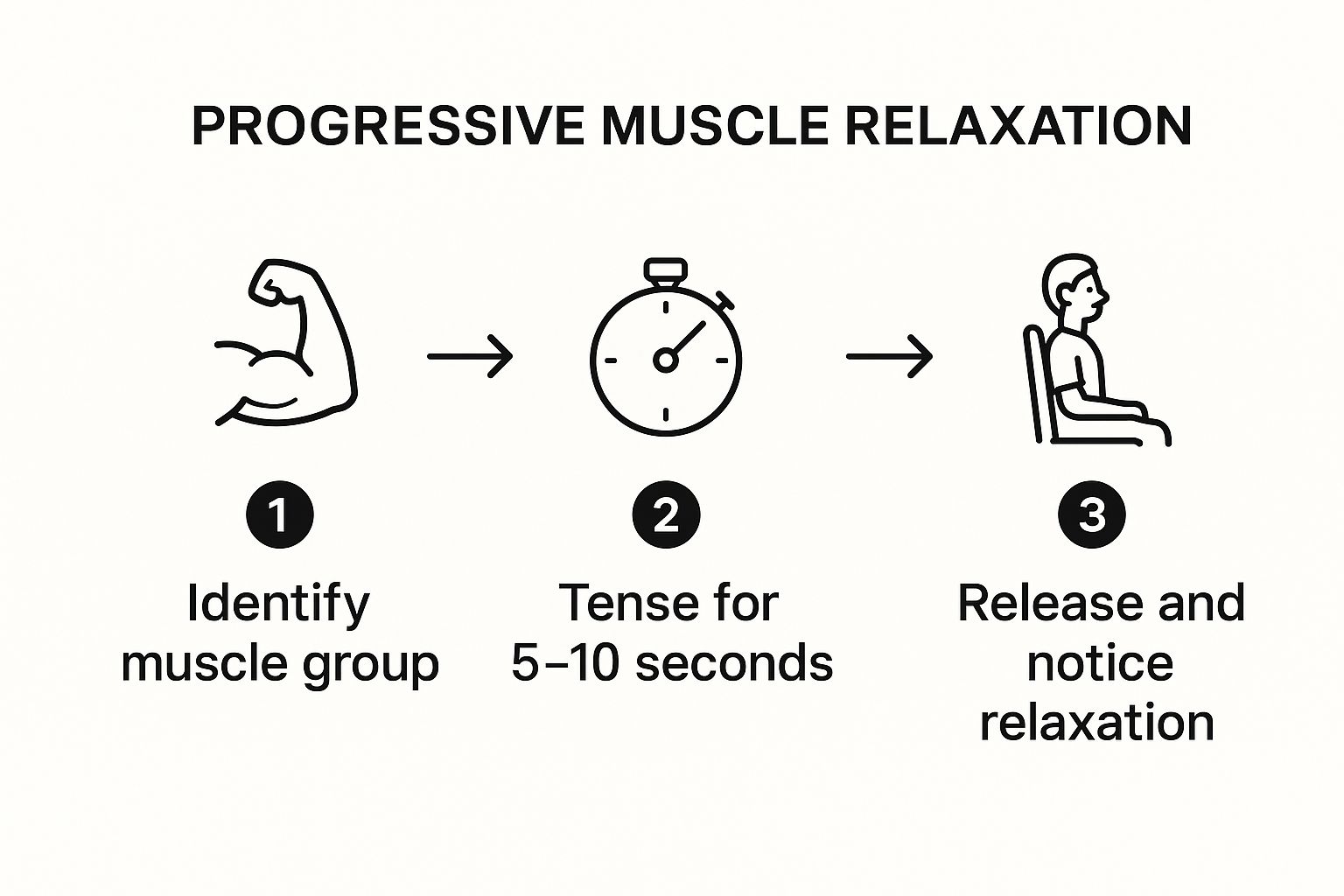
While you're working on your mind, don't forget your body. Physical relaxation techniques like the one above can calm the physical side of anxiety, making it much easier to do the mental work.
A Practical Framework For Challenging Thoughts
Okay, so you've caught yourself in an anxious thought spiral. Now what? You need a game plan. Here’s a simple but powerful framework to help you break it down.
- Catch the Thought: The second you feel that jolt of anxiety, hit pause. Ask yourself, "What's the story I'm telling myself right now?"
- Question It: Get skeptical. Is this thought 100% true? Is there any other way to look at this? What would I tell a friend if they were in my shoes?
- Replace It: Find a more balanced, realistic thought. It doesn't have to be sunshine and rainbows—just more grounded in reality.
For example, that initial thought, "I'm going to completely bomb this presentation," can be reframed. A balanced replacement might sound like, "I'm nervous, but I've prepared. I'll do my best, and it's okay if it's not perfect." See the difference?
This whole approach is backed by decades of research in Cognitive Behavioral Therapy (CBT), one of the most effective treatments for anxiety. Studies consistently show that practical strategies like these can make a huge impact, with research indicating that around 50-60% of people see a major reduction in their symptoms.
Putting It All Together: A Guide To Reframing
Let's walk through a real-world example of how to spot and reframe these unhelpful thoughts. It's a skill, and like any skill, it gets easier with practice.
This table shows how to turn a common anxious thought into something more balanced and useful.
| Anxious Thought (Cognitive Distortion) | Challenge Question | Balanced Reframe |
|---|---|---|
| "I got a C on that quiz. I'm definitely going to fail this class and never get into a good college." (Catastrophizing) | "Is one quiz really going to determine my entire future? What steps can I actually take to improve my grade?" | "I'm disappointed with this grade, but it's just one quiz. I'll talk to the teacher and make a plan to study more effectively for the next one." |
| "Everyone saw me trip in the hallway. They all think I'm such a clumsy idiot." (Mind-Reading & Personalization) | "Do I actually know what they were thinking? How long do people really think about something like that?" | "That was embarrassing, but most people are too busy with their own stuff to care. They've probably already forgotten about it." |
By consistently challenging these thoughts, you're not just putting a band-aid on your anxiety—you're rewiring the way your brain responds to stress.
This mental work is incredibly powerful. Pairing it with mindfulness practices can make you even better at observing your thoughts without getting totally swept away by them. Learning a few simple techniques is a great place to start, and there are many amazing guides on meditation for teens that can help you build that skill.
Parenting Tip: When your teen comes to you with an anxious thought, try to resist the urge to immediately say, "Don't worry about it!" Instead, you can help them build their own resilience by asking questions. Try something like, "What makes you think that?" or "What's another way to look at this situation?" This teaches them the skill of questioning their own thoughts and empowers them to manage their anxiety on their own.
Breaking The Procrastination and School Stress Cycle
Anxiety and procrastination are two sides of the same coin. I see it all the time. That feeling of dread before a big exam or an overwhelming project kicks your anxiety into high gear. To escape it, you put the task off. Procrastinate. It gives you a moment of relief, but the stress always comes back—and usually, it's even stronger.
This creates a nasty cycle that can feel impossible to break. But learning how to reduce anxiety here isn’t about just trying harder or finding more willpower. It’s about using smarter strategies to make those big tasks feel way less threatening.
This cycle is incredibly common, especially for teens. The pressure from school, grades, and thinking about the future can make any single assignment feel monumental. This isn't a sign of being lazy; it's a completely normal reaction to feeling overwhelmed. The trick is to interrupt that pattern by making the first step so ridiculously small it feels almost effortless.
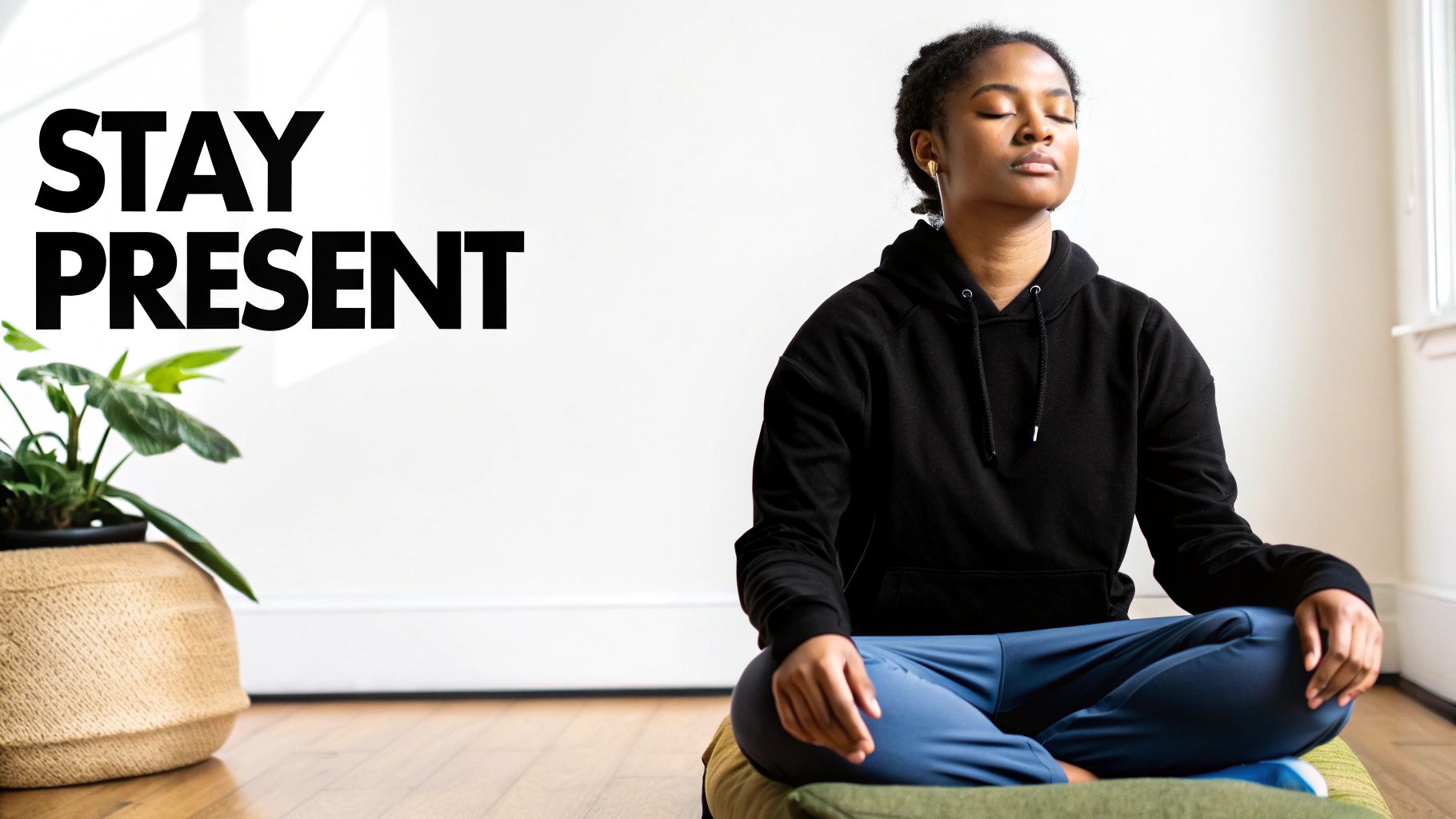
Making Starting Less Scary
Let's be real: the hardest part of any big task is just getting started. Your brain builds it up into this huge, scary monster. To shrink that monster, you need a simple but powerful technique. I call it the Two-Minute Rule.
The whole idea is to break down any overwhelming task into a version that takes less than two minutes to do. So, instead of thinking "I have to study for my history final," your new goal is "I'll open my textbook to the right chapter." Instead of "I need to write my whole English essay," it becomes "I'll open a new doc and just write one sentence."
A few other examples:
- Read one single page of your textbook.
- Do just one math problem. Not the whole worksheet. Just one.
- Brainstorm three quick ideas for your project.
This strategy is pure gold because it sidesteps the anxiety that fuels procrastination in the first place. Once you’ve actually started, inertia often takes over. Continuing feels so much easier than starting did. You essentially trick your brain into action by lowering the barrier so much it can't say no.
Managing Your Focus Without Burning Out
Okay, so you’ve started. Great. The next challenge is keeping your focus without getting totally drained. Trying to stare at a textbook for three hours straight is a guaranteed recipe for burnout and more anxiety. There's a much better way.
It’s called the Pomodoro Technique, a time-management method that uses a timer to break your work into focused, manageable chunks.
Here’s how it works:
- Choose one single task you need to work on.
- Set a timer for 25 minutes and go all-in on that one task. No phone, no distractions.
- When the timer goes off, take a 5-minute break. Seriously. Get up, stretch, grab some water—do anything but work.
- After four of these "Pomodoros," take a longer break—think 15-30 minutes.
This technique works so well because it gives you a clear finish line for each work sprint. That makes the whole thing feel more achievable and less like an endless, soul-crushing slog.
Parenting Tip: When you see your teen procrastinating, resist the urge to lecture them about deadlines. That usually just adds more pressure. Instead, help them break the task down. Ask, "What's the very first, tiny step you could take?" or suggest trying one 25-minute work session together. This models problem-solving instead of just applying pressure.
Rebuilding Motivation and Finding Support
For teens, the constant academic pressure can completely drain motivation, making it hard to even see the point of it all. A huge part of breaking the school stress cycle is setting realistic goals and then actually celebrating the small wins. Finishing one Pomodoro session is a win. Completing that single, hard math problem is a victory worth acknowledging.
And remember, you don't have to figure all this out on your own. Looking for help and reliable information is a sign of strength, not weakness. For teens who want to learn more about mental wellness, organizations like The Jed Foundation have amazing, youth-focused content. Also, the Anxiety & Depression Association of America (ADAA) provides a ton of information and support networks for teens and their families.
These resources can give you credible tools and, just as importantly, help you realize you're not the only one going through this.
It’s incredibly tough to watch your teen wrestle with anxiety. Your gut instinct might be to charge in and make it all go away, but the most powerful thing you can do is shift your role from fixer to a steady, supportive partner.
Learning how to help your teen reduce their anxiety often starts with your own approach. When you provide that solid, safe foundation for them, you give them the space they need to learn how to manage these big feelings on their own. This isn't about having all the answers—it's about showing up and being willing to figure it out together.
How to Start a Supportive Conversation
Bringing up anxiety with a teenager has to be handled with care. You're trying to open a door, not back them into a corner. Instead of hitting them with a direct, "You seem really anxious lately," which can feel like an accusation, try a softer, observation-based approach.
Something like, "I've noticed you seem to have a lot on your plate with school right now. How are you feeling about it all?" works much better. It's an invitation to share, not a demand.
Once they start talking, active listening is your superpower. Put your phone down. Make eye contact. And just listen. The hardest part is fighting the urge to jump in with solutions. Don't.
Sometimes, the most profound thing you can do is just validate what they're feeling. Simple phrases like, "That does sound incredibly stressful," or "I can see why you'd be worried about that," tell them you're on their team.
Support vs. Enabling: A Fine Line
There's a massive difference between supporting your teen through anxiety and accidentally enabling it. Support means giving them the tools and encouragement to face what scares them. Enabling is when you help them avoid the things that make them anxious.
Here’s what that looks like in the real world:
| Scenario | Enabling Response | Supportive Response |
|---|---|---|
| Your teen is terrified to give a class presentation. | "Okay, I'll email the teacher and see if you can be excused." | "I know this is really scary. Let's practice it together tonight. You can do this, and I'm here to help you prepare." |
| Your teen is avoiding homework because they're overwhelmed. | "Don't worry about it tonight, you can catch up later." | "It sounds like this assignment is a beast. Let's break it down into tiny chunks. What's one small piece we can tackle for just 15 minutes?" |
The supportive path builds resilience. It teaches your teen that they are far more capable of handling hard things than they think.
Finding Resources and Knowing When to Get Help
There are times when your support at home needs to be backed up by a professional. This is especially true for teenage boys, who often face unique pressures and benefit from practical, real-world mentorship. If you want to learn more, our article on teen boys' mental health offers some key insights into this.
It's a sign of strength, not weakness, to ask for help. If your teen's anxiety is getting in the way of school, friendships, or family life on a consistent basis, it's time to reach out to a professional.
Starting with reliable organizations can give you a solid foundation of information and support.
- The Anxiety & Depression Association of America (ADAA): They have excellent, credible resources specifically for teens and their families.
- The Jed Foundation (JED): This organization is focused on protecting emotional health and preventing suicide for teens and young adults.
These resources can empower both you and your teen with knowledge and clear next steps. You never have to navigate this alone, and your willingness to learn and find support is one of the greatest gifts you can offer.
Trusted Resources for Teen Mental Health
When you’re a teen dealing with anxiety—or a parent trying to help—the internet can feel like a minefield. Sorting through endless articles and "expert" advice is overwhelming, and it's hard to know who to trust. The key is knowing where to find credible, evidence-based support so you can stop guessing and start learning what actually helps.
Anxiety isn't just a small problem; it's a massive and growing issue worldwide. Even back in 2019, before the pandemic changed everything, data showed that about 4% of the global population was living with an anxiety disorder. It's especially common in developed countries and hits young people hard, particularly females between the ages of 10 and 14. You can dig deeper into the global impact in this in-depth public health research.
These numbers aren't just statistics. They represent real kids and families, which is why having a list of go-to, authoritative resources is so critical.
Where to Find Authoritative Information
When you need solid, reliable information, the best places to start are organizations grounded in real scientific research. These groups offer a goldmine of knowledge on everything from understanding what anxiety feels like to exploring different treatment options.
- National Institute of Mental Health (NIMH): This is the lead federal agency for research on mental health. The NIMH website is packed with detailed, easy-to-understand info on anxiety, its causes, and proven treatments. It’s an amazing starting point for both teens and parents who need foundational knowledge.
- Anxiety & Depression Association of America (ADAA): The ADAA is fantastic because it tailors its resources for different people, including a whole section just for teens. You'll find articles on handling school stress, dealing with social anxiety, and even tips on how to talk to your parents about what’s going on.
A Quick Tip for Parents: When your teen is suddenly unmotivated or procrastinating on schoolwork, it's easy to jump to conclusions. But often, this is a symptom of underlying anxiety. Instead of focusing only on the missing assignments, try exploring these resources together. It shifts the conversation from blame to supportive, collaborative problem-solving.
Teen-Focused Support and Helplines
Sometimes you need support that feels more immediate or is built specifically for a younger audience. These resources are designed to be accessible and speak your language.
The image below from the NIMH shows exactly what I mean by clear, helpful information. They break down a complex topic like anxiety into manageable pieces.

This page acts like a central hub, pointing you toward specific types of anxiety and evidence-based ways to get help. Having a list of go-to sites like this one can make a world of difference, empowering both you and your parents to find answers quickly and confidently.
Common Questions I Get About Teen Anxiety
When you're dealing with anxiety, whether as a teen or as a parent trying to help, a lot of questions come up. Let's break down some of the most common ones I hear and get straight to the practical answers.
How Can I Support My Teen Without Enabling Their Anxiety?
This is probably one of the toughest things for a parent to navigate. You see your kid hurting, and your first instinct is to make the pain go away. But there’s a fine line between supporting them and accidentally making it easier for them to avoid the things that scare them.
True support means being their co-pilot, not clearing the runway for them.
Let’s say they’re completely overwhelmed by a big school project. An enabling response would be to email the teacher yourself and ask for an extension. A supportive response sounds more like, "I get it, this feels like a mountain. What's the very first, smallest step we can figure out together?" This helps them build the skill of breaking down a challenge, rather than just removing the challenge for them.
One of the most powerful things you can do is model healthy coping yourself. Talk openly—in an age-appropriate way, of course—about a time you felt stressed and what you did about it. It shows them these feelings are a normal part of life and there are ways to move through them.
What’s the Real Connection Between Anxiety, School, and Motivation?
Think of anxiety as the ultimate motivation-killer. When your brain is stuck in a fight-or-flight loop, it’s almost physically impossible to focus on something like a chemistry formula or a history essay. Your brain is screaming "DANGER!" and the textbook just isn't a priority.
This is why so many anxious teens procrastinate. It's not laziness. It's a coping mechanism. Putting off that stressful task gives them a temporary hit of relief from the anxiety.
It’s so important to reframe this behavior. The problem isn’t a lack of desire to do well—it’s that the fear of not doing well enough feels paralyzing. The only way to truly fix the motivation issue is to address the anxiety at its root. Once the fear subsides, genuine motivation has a chance to come back online.
Where Can My Teen Find Mental Health Info That Isn't Garbage?
The internet can feel like a minefield of bad advice. The key is to stick with established, reputable organizations that provide teen-focused resources grounded in actual research.
Here are a few of the best places to start:
- The Anxiety & Depression Association of America (ADAA): They have an entire section for teens with great articles on everything from school stress to social anxiety.
- The Jed Foundation (JED): JED is all about protecting emotional health for teens and young adults. They offer real-world tips and support that feel relevant and useful.
- National Institute of Mental Health (NIMH): If you want to go deep into the science and research, the NIMH is an incredible resource for both teens and their parents.
These sites offer credible, trustworthy information. They’re a fantastic first step for anyone who wants to understand mental health better and find strategies that actually make a difference.
Are you a parent watching your teen get stuck in a cycle of anxiety, procrastination, and school pressure? Andrew Petrillo Life Coaching offers personalized, one-on-one coaching to help them build the practical skills and confidence they need to move forward. Learn how to turn overwhelm into action by visiting https://andrewpetrillolifecoaching.com.





